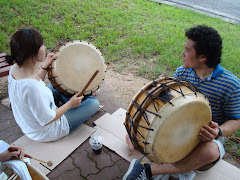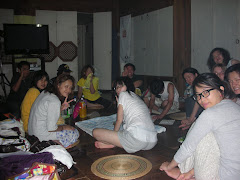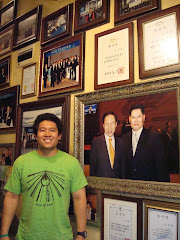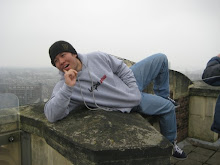My last weekend in Korea was spent with close friends. I couldn't think of a better way to end my time in Korea. We first saw Ice Age 3 early on Saturday morning, and then went ice skating at Lotte World in the afternoon. I love ice skating, and it was a lot of fun, especially since it was the first time skating for my good friend. She never fell once, which was amazing! Although I told her it would have been good to fall; that's how you learn. I fell on purpose a couple times, which was good fun. After ice skating, we went back to my friends place where she cooked us a delicious dinner. We also played charades late into the night, until I got asked to act out "생일." It was then that I realized that my friends had been planning a surprise birthday for me all along, as they brought out a birthday cake and started singing "Happy Birthday" in Korean. My birthday wasn't even in two weeks, but they still remembered. I was so touched by their kind and thoughtful gesture. I had known these people for only two and a half months, some even less than that, but yet we had forged very close relationships with one another, ones that I think will last a really long time even beyond Korea. No one had ever really done this for me before, and I was touched by their thoughtfulness and selflessness. My friends that night showed me the importance of thinking about others before yourself, and just how far a little act of kindness and thoughtfulness can go. It meant so much to me that they would do that for me, and I will never forget their kindness. Probably the best way I could've ended my time here.
During my last two days in Korea, I must have gone to the batting cages at least four times. I wish I had started going to them earlier during my stay. They are so easy, accessible, and cheap to use; you get about twelve balls for only fifty cents! It was there that I met up with my Korean tutor for the last time. We hit some balls and talked story. From the beginning of the term, he volunteered his time to meet me once a week and help me with my Korean. He was more like a friend than a tutor, and I thought of him as an older brother. We'd usually just talk story when we met, which was not only a great way to practice my Korean, but also a good way to learn about Korea. I have a feeling we will meet again. I definitely owe him one.
And at my hasukjib...I decided to get green tea ice cream one more time for Nuna out of gratitude for all of the hard work she has done. I brought some ice cream back for all the students at the hasukjib, and we ate dinner and ice cream late into the night, longer than we usually do. Nuna made 감자탕 (gamja tang) for my last night and "toast" for my last breakfast (her toast was my favorite breakfast, and it's like no other toast I have ever tried before). I realized that life at the hasukjib is continually changing and only temporary; people come and go, students move in to bedrooms once the bedrooms of past students. That night there was a new Korean student who joined us for dinner; it was his first dinner at the hasukjib. And with me moving out the next day, the cycle of incoming and outgoing students continued. Life goes on.
명I used to think that people come in and out of one's life at certain times for a reason, and that one should accept the moment at which people are meant to go out of one's life. But for the first time, I didn't want to leave the people I had spent the last two and a half months with. I felt an attachment to them and a strong bond and friendship. I never really thought about the idea of such people coming back into one's life once they have left. Perhaps, rather than ever going out of one's life at all, some people are meant to stay in our lives, rather than coming in and out...주





















































































































